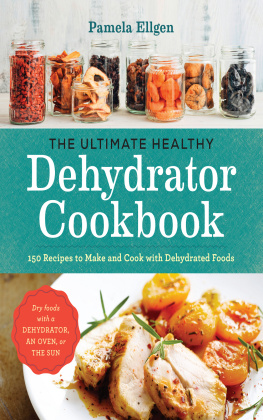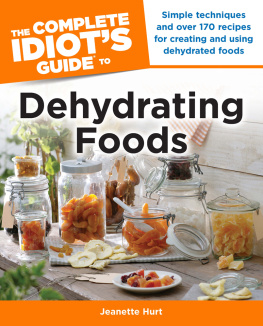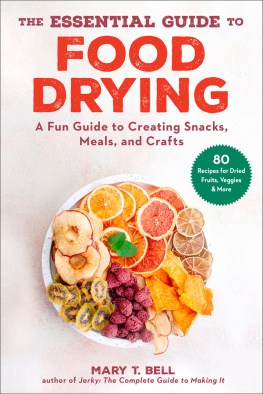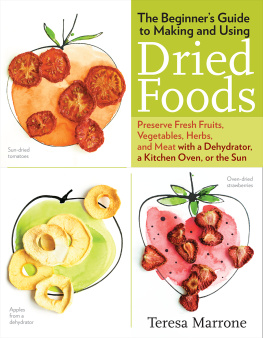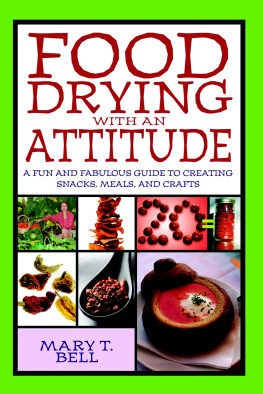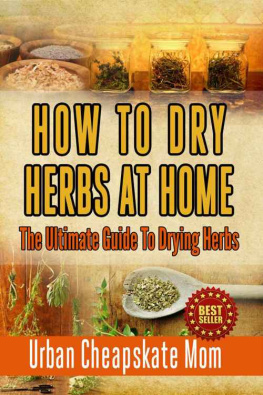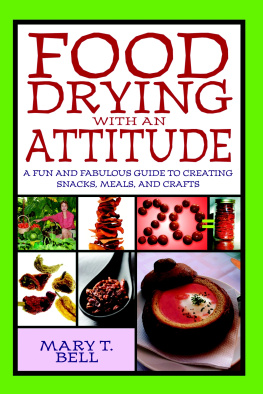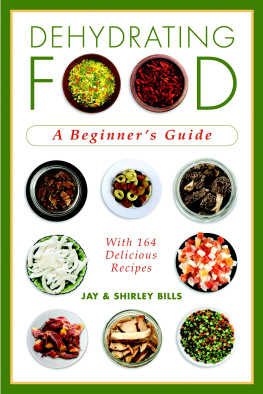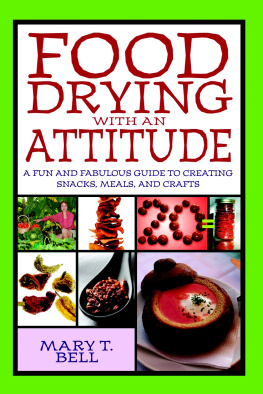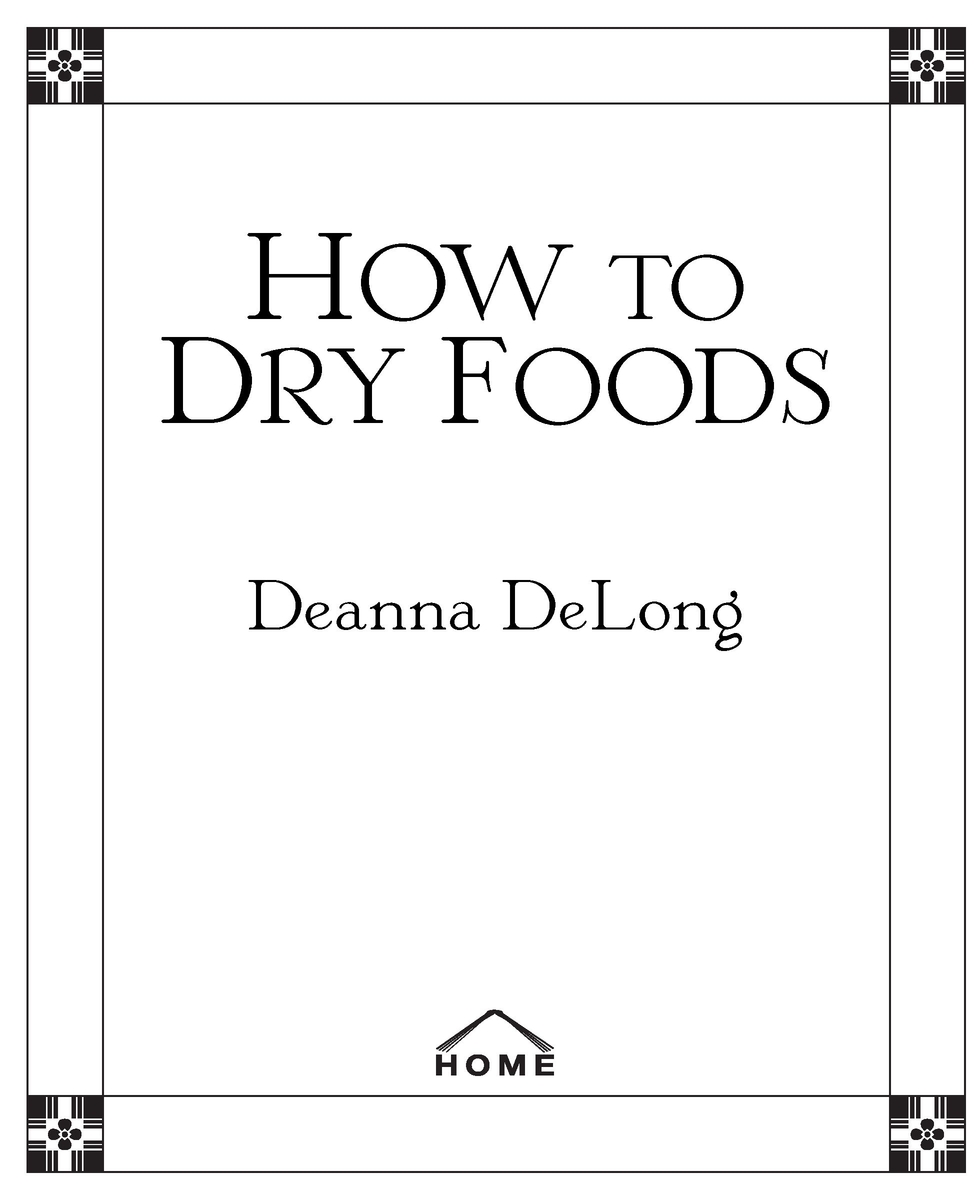Table of Contents
Most Home Books are available at special quantity discounts for bulk purchases for sales promotions, premiums, fund-raising, or educational use. Special books, or book excerpts, can also be created to fit specific needs.
For details, write: Special Markets, The Berkley Publishing Group, 375 Hudson Street, New York, New York 10014.
To my patient and devoted husband, David, who always encourages my creativity and tirelessly supports me in my endeavors, even when it means being on his own while Im off in some far corner of the earth.
To my incredible grown children, Alyson Whitaker, Isaac DeLong, and Shepard DeLong, who grew up peeling apples and preparing foods to dry without ever complainingand who now dry foods with my grandchildren.
ACKNOWLEDGMENTS
I would like to thank the amazing people in the Republic of Georgia, Mozambique, Poland, Hungary, Guatemala, El Salvador, Costa Rica, and Honduras who touched and enriched my life as I taught them about food dehydration.
Many thanks to my dear friend and colleague Leon Cooper, who traveled with me on many of my projects to teach about food dehydration in developing countries, and who is always up for a new adventure. His positive attitude, ingenuity, and enthusiasm made even the most challenging projects successful... and fun!
There arent words to express my gratitude to Dr. George York, retired professor from the University of California, Davis, who believed in me twenty-six years ago and encouraged me to write How to Dry Foods. Dr. Yorks expertise in food preservation was invaluable to the technical accuracy of this book.
I am grateful to my fantastic editor, Jeanette Egan, for her brilliant and insightful editing of this book. Her assistance was indispensable.
And most of all, I am thankful to my Father in Heaven for the divine inspiration that allowed me to write this book and share the experience of drying foods with enthusiastic people throughout the world.
ADVANTAGES OF DRYING FOODS
Preserving foods is not a new idea. Many of us have preserved foods by canning or freezing. Drying is another method of preserving foods in season for use when theyre not readily available. It also adds a new variety of snack food to your daily menus.
DRIED FRUITS ARE TASTY
Dried fruits and fruit rolls are delicious, and quite different from the same fruits when fresh. A dried peach tastes peachier than a fresh peach. The chewy texture and extra sweet flavor of dried fruits makes them a favorite of all ages.
DRIED FOODS ARE ECONOMICAL
Drying food at home is fairly inexpensive. A high-quality home food dehydrator can easily pay for itself in a summer or two. When comparing commercially dried foods to home dried, youll notice that it is considerably less expensive to dry your own. When you dry your own, youre not paying for the expensive packaging and advertising that you pay for when purchasing commercially dried foods.
You can buy foods in season, go to U-Pick farms and local produce markets, or grow your own. Seasonal drying greatly increases the savings for your family.
Watch for specials at the supermarket for more savings.
DRIED FOODS ARE NUTRITIOUS
Dried fruits and fruit leathers are especially good replacements for sugar-laden snacks. However, there are more calories in dried foods on a weight-for-weight basis because the nutrients are concentrated. Be aware that 100 grams of fresh apricots have 51 calories, and 100 grams of dried apricots have 260 calories! Most dried fruits contain more than two times the calories of the same fruit fresh.
Nutritionally, drying compares well with other methods of preservation. For most foods, the nutritional value retained is about the same as with freezing. Drying has a lower heat exposure than canning and therefore destroys fewer vitamins. The nutrient losses during most drying processes are small in comparison to the loss during cooking. Using a pretreatment for apples, peaches, and pears lessens the loss of vitamins A and C.
The fiber and carbohydrates are not affected by drying. Neither are the minerals, such as potassium or magnesium, in some fruits.
If youre concerned about additives and preservatives, drying your own foods allows you to control what goes into the foods you eat.
DRIED FOODS TAKE UP MINIMAL STORAGE SPACE
Dried foods take from one-tenth to one-twentieth of the volume of frozen or canned, depending on how much water is in the fresh fruit.
If you store foods for emergencies or economy, the low volume of dried foods makes them very practical for your stored food supply. You can store twenty fresh tomatoes in a one-pint jar when theyre dried, compared to three or four quarts for the same amount canned!
Their light weight and low volume are reasons why dried fruits are so popular with backpackers, campers, and people on the go.
DRYING FOODS AND CRAFTS AT HOME IS FUN
Because dehydrating most foods does not require a stove or boiling water, it can be a safe and fun family activity. Even small children enjoy taking the pits out of fruits or placing prepared fruits on trays.
Drying is so easy that even the beginner will have success if the simple instructions in this book are followed. If youre an experienced food preserver, be adventuresome and experiment with different combinations of fruits and vegetables.
If you love crafts, try making dried apple wreaths (page 138), potpourri (page 139), dried flowers (page 135), and even dried dough ornaments (page 140).
The good news about drying is that you rarely can make a serious mistake. Most dried foods are edible, even if you dont exactly follow all of the instructions in the book (the exceptions are fish and meat, which must be dried exactly as instructed).
THE SAFETY OF DRIED FOODS
Generally, the only food-safety issues you would have with dried foods are mold and fermentation, both of which are readily apparent, unlike with canned foods that may contain harmful bacteria while appearing to be unspoiled. You can see mold and you can smell fruits when theyve fermented. If dried food is moldy or fermented, throw it away.
Jerky, other dried meats, and fish need extraspecial care. If you choose to dry these products, read and follow the instructions in this book carefully.
Always observe good hygiene practices in the kitchen as you prepare foods for drying, or as you are packaging them. Wash your hands frequently with hot, soapy water, especially after touching something other than the foods. Keep your utensils and dehydrator trays squeaky clean. Use clean towels or dishcloths. Thoroughly wash all fruits and vegetables before preparing for drying.
HISTORY OF DRYING
Dried food has been used for survival from early nomadic days to modern times. Ancient Egyptians and Greeks are known to have dried food.
Early seagoing expeditions survived on dried fruit, grains, and meats. Columbus probably would never have discovered America if he hadnt fed himself and his crew with dried foods!
Drying was a necessity for the colonists and early settlers of the New World, or any place where homes had to be self-reliant during the winter. Fruits, especially apples, pears, peaches, and apricots, and some vegetables were dried for winter use. Quantities of fish and meat were dried and heavily salted to reduce spoilage. They were so salty that its a wonder how they managed to eat them.


